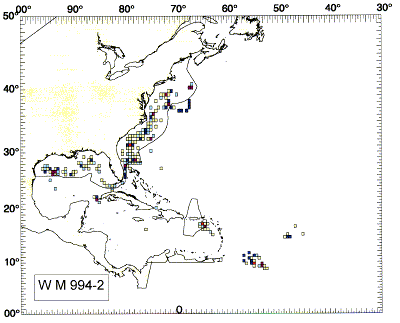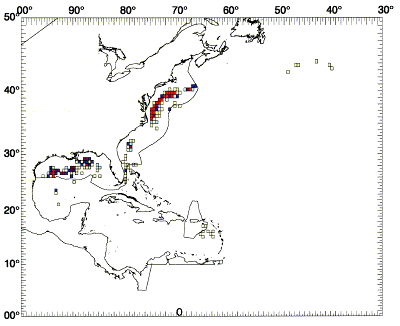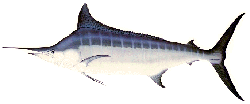 |
 |
 |
 |
 |
 |
 |
 |
 |
 |
 |
 |
 |
 |
 |
 |
 |
 |
 |
 |
 |
 |
 |
 |
 |
 |
 |
 |
|
Critical Habitat of White Marlin |
|
|
|
 |
|
|
|
 |
|
|
|
|
SPAWNING AREAS - These two charts (1994 above and 1995 below) show where U.S. longline vessels reported catching the greatest numbers of adult white marlin during the second quarter.� (Color code:� red >16, magenta 8-16, dark blue 4-8, pale blue 2-4, and yellow 1-2)� This quarter includes the peak period of white marlin spawning activity.� White marlin spawn in the Caribbean region from March through mid June with the peak in May.� The primary spawning locations appear to include the area between the Bahamas, Cuba and Florida (an area in which U.S. vessels are not permitted to fish thus no catch records are shown on either chart), the gaps or passages between the larger Caribbean islands (such as at each end of Cuba, Hispanola and Puerto Rico), a site SSE of St. Croix, and two "hot spots" located well east of the Caribbean chain of islands.� These two open Atlantic areas are positioned on two major current systems - the North Equatorial and the South Equatorial. A map showing generalized surface currents of the North Atlantic is available (HERE). These same areas are also primary spawning areas for blue marlin and for swordfish.�
The scientific community already accepts the fact that there is both a North Atlantic and a South Atlantic population of swordfish, which do not interbreed.� We believe there is also a northern hemisphere population of white marlin (and blue marlin).� It spawns at these "hot spots" during the northern hemisphere's spring.� The southern hemisphere population of white marlin (and blue marlin) spawns in the Royal Charlotte Bank area just north of Cabo Frio Brazil (site of many world record marlin catches) during the southern hemisphere's spring (thus phased 6 months behind the northern hemisphere).� For larger scale maps, see our Bycatch Maps section: (white marlin)(blue marlin). The catch of white marlin to the north of the primary spawning areas reflects the return of some fish to their summer and fall feeding grounds following spawning. |
|
|
|
|
White Marlin Catch 1994, 2nd Q |
|
|
|
|
|
 |
|
|
|
|
|
White Marlin Catch 1995, 2nd Q |
|
|
 |
|
|
Feeding Grounds - The chart on the left shows where adult white marlin concentrate from summer through late fall every year.� The third quarter of 1994 is pictured here.� The mid-Atlantic "hot spot" is located on the edge of the continental shelf between the 100 and 1,000 fathom depth contours and extending from the eastern tip of Georges Bank off Massachusetts to just below Cape Hatteras, NC.� The 3 Gulf of Mexico "hot spots" include the de Soto Canyon off Pensacola, FL, the area near the Flower Garden Banks off Texas and a spot midway between these two "hot spots."�� These are also located generally between the 100 and 1,000 fathom depth contours. These "hot spots" are positioned on the (inshore) edge�of major surface currents - the Gulf Stream and the Loop Current (in the Gulf of Mexico). White marlin (and blue marlin) will remain in these primary feeding area "hot spots" until cold temperatures drive them back south for the winter. |
|
|
|
|
White Marlin Catch 1994, 3rd Q |
|
|
|
These white marlin "hot spots" are not just the areas where the longliners fish most heavily. As can be seen in the following plots showing the yearly extent of U.S. longline vessels sets (1992, 1995, 1996 and 1997), longliners are covering a much greater area of the North Atlantic than just the area of these "hot spots." In fact, we estimate that closing all the white marlin's "hot spots" would deny longliners access to only about 2% of the area they normally fish but it would eliminate about 85% of their interactions with white marlin.
In our petition, we recommend (1) that these critical habitats in U.S. EEZ waters (200-mile boundary shown on these charts) be closed to commercial fishing for large pelagic species (swordfish, tunas, sharks, etc.) by U.S. vessels (thus also setting a good example), and (2) that the U.S. government aggressively seek international agreement at ICCAT to prohibit all commercial fishing at least in the white marlin's primary spawning area "hot spots" depicted above.� Commercial fishing vessels are responsible for 99.89% of the total reported mortality to white marlin.� The recreational fishing community is responsible for 0.11% of the reported Atlantic-wide mortlity.� Accordingly, we recommended that no restrictions be placed on this sector.� It has voluntarily reduced its mortality to near zero (a total of only 8 white marlin were reported killed in the latest year, 2000) by practicing catch-and-release (nearly 99% as currently self-reported). |
|
|
|
Major Sections of our Website
Swordfish,� Billfish,� Tunas� and� Sharks
Critical Habitat Maps for Blue Marlin
Severity of Atlantic Population Declines (Marlin, Bluefin Tuna, Swordfish, Sailfish and Sharks)
White Marlin ESA Listing Petition
Articles about Big Game Fish and Fishing
Photos of Big Game Species
Wetlands,� Estuaries,� Rivers� and� Coastal� Habitat
Importance to Marine Fish
Chambers and Associates
Description
List of All Pages on this Website
Home |
|
|
 |
|
|
|
|
|
Chambers and Associates
9814 Kensington Parkway
Kensington Maryland 20895-3425
(T) 301-949-7778��� (Fax) 301-949-3003 |
|
|
|
|




